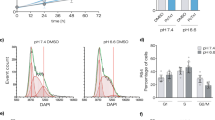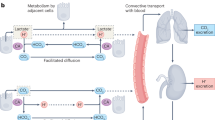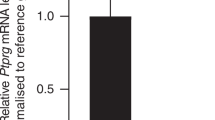Abstract
The low extracellular pH in the microenvironment has been shown to promote tumor growth and metastasis; however, the underlying mechanism is poorly understood. Particularly, little is known how the tumor cell senses the acidic signal to activate the acidosis-mediated signaling. In this study, we show that breast cancer cells express acid-sensing ion channel 1 (ASIC1), a proton-gated cation channel primarily expressed in the nervous system. RNA interference, knockout and rescue experiments demonstrate a critical role for ASIC1 in acidosis-induced reactive oxidative species and NF-κB activation, two key events for tumorigenesis. Mechanistically, ASIC1 is required for acidosis-mediated signaling through calcium influx. We show that as a cytoplasmic membrane protein, ASIC1 is also associated with mitochondria, suggesting that ASIC1 may regulate mitochondrial calcium influx. Importantly, interrogation of the Cancer Genome Atlas breast invasive carcinoma data set indicates that alterations of ASIC1 alone or combined with other 4 ASIC genes are significantly correlated with poor patient survival. Furthermore, ASIC1 inhibitors cause a significant reduction of tumor growth and tumor load. Together, these results suggest that ASIC1 contributes to breast cancer pathogenesis in response to acidic tumor microenvironments, and ASIC1 may serve as a prognostic marker and a therapeutic target for breast cancer.
This is a preview of subscription content, access via your institution
Access options
Subscribe to this journal
Receive 50 print issues and online access
$259.00 per year
only $5.18 per issue
Buy this article
- Purchase on Springer Link
- Instant access to full article PDF
Prices may be subject to local taxes which are calculated during checkout






Similar content being viewed by others
References
Gatenby RA, Gillies RJ . Why do cancers have high aerobic glycolysis? Nat Rev Cancer 2004; 4: 891–899.
Abbey CK, Borowsky AD, McGoldrick ET, Gregg JP, Maglione JE, Cardiff RD et al. In vivo positron-emission tomography imaging of progression and transformation in a mouse model of mammary neoplasia. Proc Natl Acad Sci USA 2004; 101: 11438–11443.
Estrella V, Chen T, Lloyd M, Wojtkowiak J, Cornnell HH, Ibrahim-Hashim A et al. Acidity generated by the tumor microenvironment drives local invasion. Cancer Res 2013; 73: 1524–1535.
Robey IF, Baggett BK, Kirkpatrick ND, Roe DJ, Dosescu J, Sloane BF et al. Bicarbonate increases tumor pH and inhibits spontaneous metastases. Cancer Res 2009; 69: 2260–2268.
Gupta SC, Singh R, Pochampally R, Watabe K, Mo YY . Acidosis promotes invasiveness of breast cancer cells through ROS-AKT-NF-kappaB pathway. Oncotarget 2014; 5: 12070–12082.
Xu L, Fidler IJ . Acidic pH-induced elevation in interleukin 8 expression by human ovarian carcinoma cells. Cancer Res 2000; 60: 4610–4616.
Peppicelli S, Bianchini F, Contena C, Tombaccini D, Calorini L . Acidic pH via NF-kappaB favours VEGF-C expression in human melanoma cells. Clin Exp Metastasis 2013; 30: 957–967.
Damaghi M, Wojtkowiak JW, Gillies RJ . pH sensing and regulation in cancer. Front Physiol 2013; 4: 370.
Wemmie JA, Askwith CC, Lamani E, Cassell MD, Freeman JH Jr . Welsh MJ . Acid-sensing ion channel 1 is localized in brain regions with high synaptic density and contributes to fear conditioning. The J Neurosci 2003; 23: 5496–5502.
Schaefer L, Sakai H, Mattei M, Lazdunski M, Lingueglia E . Molecular cloning, functional expression and chromosomal localization of an amiloride-sensitive Na(+) channel from human small intestine. FEBS Lett 2000; 471: 205–210.
Waldmann R, Champigny G, Bassilana F, Heurteaux C, Lazdunski M . A proton-gated cation channel involved in acid-sensing. Nature 1997; 386: 173–177.
Chu XP, Xiong ZG . Physiological and pathological functions of acid-sensing ion channels in the central nervous system. Curr Drug Targets 2012; 13: 263–271.
Berdiev BK, Xia J, McLean LA, Markert JM, Gillespie GY, Mapstone TB et al. Acid-sensing ion channels in malignant gliomas. J Biol Chem 2003; 278: 15023–15034.
Bubien JK, Keeton DA, Fuller CM, Gillespie GY, Reddy AT, Mapstone TB et al. Malignant human gliomas express an amiloride-sensitive Na+ conductance. Am J Physiol 1999; 276: C1405–C1410.
Wemmie JA, Taugher RJ, Kreple CJ . Acid-sensing ion channels in pain and disease. Nat Rev Neurosci 2013; 14: 461–471.
Wemmie JA, Chen J, Askwith CC, Hruska-Hageman AM, Price MP, Nolan BC et al. The acid-activated ion channel ASIC contributes to synaptic plasticity, learning, and memory. Neuron 2002; 34: 463–477.
Bianchi L, Driscoll M . Protons at the gate: DEG/ENaC ion channels help us feel and remember. Neuron 2002; 34: 337–340.
Ugawa S, Ueda T, Ishida Y, Nishigaki M, Shibata Y, Shimada S . Amiloride-blockable acid-sensing ion channels are leading acid sensors expressed in human nociceptors. J Clin Invest 2002; 110: 1185–1190.
Chen X, Kalbacher H, Grunder S . The tarantula toxin psalmotoxin 1 inhibits acid-sensing ion channel (ASIC) 1a by increasing its apparent H+ affinity. J Gen Physiol 2005; 126: 71–79.
Jinek M, Chylinski K, Fonfara I, Hauer M, Doudna JA, Charpentier E . A programmable dual-RNA-guided DNA endonuclease in adaptive bacterial immunity. Science 2012; 337: 816–821.
Ho TT, Zhou N, Huang J, Koirala P, Xu M, Fung R et al. Targeting non-coding RNAs with the CRISPR/Cas9 system in human cell lines. Nucleic Acids Res 2015; 43: e17.
Minn AJ, Gupta GP, Siegel PM, Bos PD, Shu W, Giri DD et al. Genes that mediate breast cancer metastasis to lung. Nature 2005; 436: 518–524.
Xiong ZG, Zhu XM, Chu XP, Minami M, Hey J, Wei WL et al. Neuroprotection in ischemia: blocking calcium-permeable acid-sensing ion channels. Cell 2004; 118: 687–698.
Brookes PS, Yoon Y, Robotham JL, Anders MW, Sheu SS . Calcium, ATP, and ROS: a mitochondrial love-hate triangle. Am J Physiol Cell Physiol 2004; 287: C817–C833.
Viola HM, Arthur PG, Hool LC . Transient exposure to hydrogen peroxide causes an increase in mitochondria-derived superoxide as a result of sustained alteration in L-type Ca2+ channel function in the absence of apoptosis in ventricular myocytes. Circ Res 2007; 100: 1036–1044.
Giorgio V, Soriano ME, Basso E, Bisetto E, Lippe G, Forte MA et al. Cyclophilin D in mitochondrial pathophysiology. Biochim Biophys Acta 2010; 1797: 1113–1118.
Benarroch EE . Acid-sensing cation channels: structure, function, and pathophysiologic implications. Neurology 2014; 82: 628–635.
Gao J, Aksoy BA, Dogrusoz U, Dresdner G, Gross B, Sumer SO et al. Integrative analysis of complex cancer genomics and clinical profiles using the cBioPortal. Sci Signal 2013; 6: pl1.
Cerami E, Gao J, Dogrusoz U, Gross BE, Sumer SO, Aksoy BA et al. The cBio cancer genomics portal: an open platform for exploring multidimensional cancer genomics data. Cancer Discov 2012; 2: 401–404.
Hashim AI, Zhang X, Wojtkowiak JW, Martinez GV, Gillies RJ . Imaging pH and metastasis. NMR Biomed 2011; 24: 582–591.
McCubrey JA, Lahair MM, Franklin RA . Reactive oxygen species-induced activation of the MAP kinase signaling pathways. Antioxid Redox Signal 2006; 8: 1775–1789.
Zha XM . Acid-sensing ion channels: trafficking and synaptic function. Mol Brain 2013; 6: 1.
Feissner RF, Skalska J, Gaum WE, Sheu SS . Crosstalk signaling between mitochondrial Ca2+ and ROS. Front Biosci (Landmark Ed) 2009; 14: 1197–1218.
Granfeldt D, Samuelsson M, Karlsson A . Capacitative Ca2+ influx and activation of the neutrophil respiratory burst. Different regulation of plasma membrane- and granule-localized NADPH-oxidase. J leukoc Biol 2002; 71: 611–617.
Wang G, Anrather J, Glass MJ, Tarsitano MJ, Zhou P, Frys KA et al. Nox2, Ca2+, and protein kinase C play a role in angiotensin II-induced free radical production in nucleus tractus solitarius. Hypertension 2006; 48: 482–489.
Prevarskaya N, Skryma R, Shuba Y . Calcium in tumour metastasis: new roles for known actors. Nat Rev Cancer 2011; 11: 609–618.
El Jamali A, Valente AJ, Lechleiter JD, Gamez MJ, Pearson DW, Nauseef WM et al. Novel redox-dependent regulation of NOX5 by the tyrosine kinase c-Abl. Free Radical Biol Med 2008; 44: 868–881.
Pandey D, Gratton JP, Rafikov R, Black SM, Fulton DJ . Calcium/calmodulin-dependent kinase II mediates the phosphorylation and activation of NADPH oxidase 5. Mol Pharmacol 2011; 80: 407–415.
Rizzuto R, Pozzan T . Microdomains of intracellular Ca2+: molecular determinants and functional consequences. Physiol Rev 2006; 86: 369–408.
Berridge MJ, Bootman MD, Lipp P . Calcium—a life and death signal. Nature 1998; 395: 645–648.
Drago I, Pizzo P, Pozzan T . After half a century mitochondrial calcium in- and efflux machineries reveal themselves. EMBO J 2011; 30: 4119–4125.
Berridge MJ, Lipp P, Bootman MD . The versatility and universality of calcium signalling. Nat Rev Mol cell Biol 2000; 1: 11–21.
Pinton P, Giorgi C, Siviero R, Zecchini E, Rizzuto R . Calcium and apoptosis: ER-mitochondria Ca2+ transfer in the control of apoptosis. Oncogene 2008; 27: 6407–6418.
Banfi B, Molnar G, Maturana A, Steger K, Hegedus B, Demaurex N et al. A Ca(2+)-activated NADPH oxidase in testis, spleen, and lymph nodes. J Biol Chem 2001; 276: 37594–37601.
Jagnandan D, Church JE, Banfi B, Stuehr DJ, Marrero MB, Fulton DJ . Novel mechanism of activation of NADPH oxidase 5. calcium sensitization via phosphorylation. J Biol Chem 2007; 282: 6494–6507.
Banfi B, Tirone F, Durussel I, Knisz J, Moskwa P, Molnar GZ et al. Mechanism of Ca2+ activation of the NADPH oxidase 5 (NOX5). J Biol Chem 2004; 279: 18583–18591.
Zhang A, Zhou N, Huang J, Liu Q, Fukuda K, Ma D et al. The human long non-coding RNA-RoR is a p53 repressor in response to DNA damage. Cell Res 2013; 23: 340–350.
Gupta SC, Francis SK, Nair MS, Mo YY, Aggarwal BB . Azadirone, a limonoid tetranortriterpene, induces death receptors and sensitizes human cancer cells to tumor necrosis factor-related apoptosis-inducing ligand (TRAIL) through a p53 protein-independent mechanism: evidence for the role of the ROS-ERK-CHOP-death receptor pathway. J Biol Chem 2013; 288: 32343–32356.
Ye JH, Gao J, Wu YN, Hu YJ, Zhang CP, Xu TL . Identification of acid-sensing ion channels in adenoid cystic carcinomas. Biochem Biophys Res Commun 2007; 355: 986–992.
Sachdeva M, Mo YY . MicroRNA-145 suppresses cell invasion and metastasis by directly targeting mucin 1. Cancer Res 2010; 70: 378–387.
Huang J, Zhou N, Watabe K, Lu Z, Wu F, Xu M et al. Long non-coding RNA UCA1 promotes breast tumor growth by suppression of p27 (Kip1). Cell Death Dis 2014; 5: e1008.
Tomayko MM, Reynolds CP . Determination of subcutaneous tumor size in athymic (nude) mice. Cancer Chemother Pharmacol 1989; 24: 148–154.
Acknowledgements
We thank Dr Parminder J.S. Vig at UMMC for providing mouse brain tissues. This work is supported in part by a grant from the National Institutes of Health R01 CA154989 (YM) and a grant from UMMC’s Intramural Research Support Program (SCG). Imaging Core of Center for Psychiatric Neuroscience at UMMC is supported by COBRE grant GM103328.
Author information
Authors and Affiliations
Corresponding author
Ethics declarations
Competing interests
The authors declare no conflict of interest.
Additional information
Supplementary Information accompanies this paper on the Oncogene website
Supplementary information
Rights and permissions
About this article
Cite this article
Gupta, S., Singh, R., Asters, M. et al. Regulation of breast tumorigenesis through acid sensors. Oncogene 35, 4102–4111 (2016). https://doi.org/10.1038/onc.2015.477
Received:
Revised:
Accepted:
Published:
Issue Date:
DOI: https://doi.org/10.1038/onc.2015.477
This article is cited by
-
Acid-sensing ion channels and downstream signalling in cancer cells: is there a mechanistic link?
Pflügers Archiv - European Journal of Physiology (2024)
-
Acid-sensing ion channel 1a exacerbates renal ischemia–reperfusion injury through the NF-κB/NLRP3 inflammasome pathway
Journal of Molecular Medicine (2023)
-
Somatic copy number alteration predicts clinical benefit of lung adenocarcinoma patients treated with cytokine-induced killer plus chemotherapy
Cancer Gene Therapy (2022)
-
Piperlongumine, a piper alkaloid, enhances the efficacy of doxorubicin in breast cancer: involvement of glucose import, ROS, NF-κB and lncRNAs
Apoptosis (2022)
-
Management of oxidative stress and inflammation in cardiovascular diseases: mechanisms and challenges
Environmental Science and Pollution Research (2021)



